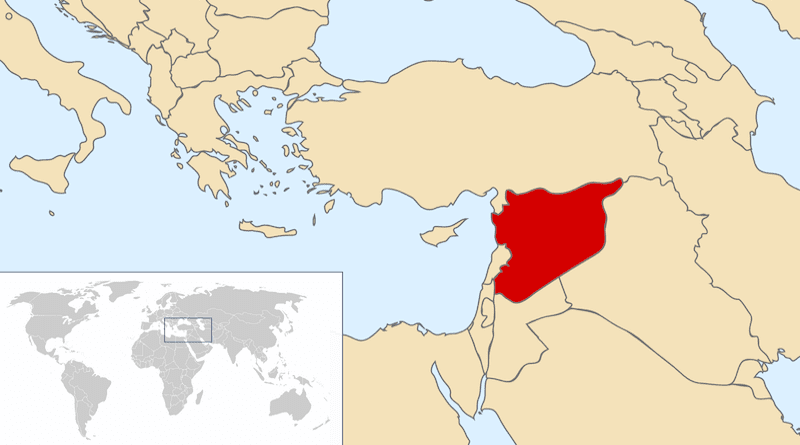Syrian Rebels Step Up Efforts To Get Anti-Aircraft Missiles
By VOA
By Jamie Dettmer
Syrian rebels are redoubling their efforts to acquire portable anti-aircraft missiles following government airstrikes on cities and towns in the north of the country.
In the latest such strike, a Syrian Air Force jet bombed the rebel-held town of Azaz near the Turkish border, killing at least 50 people and wounding more than 100.
Rebel commanders and activists say their buyers are now scouring the arms black markets in the region to get the shoulder-fired missiles that can counter the government airstrikes.
According to opposition activist “Tony” al-Taieb, who works with the rebel military council in Aleppo, representatives with cash from rich Syrian exiles are negotiating to buy the portable surface-to-air missiles, often called SAMS or MANPADS, for “Man-Portable-Air-Defense-System.”
“Don’t believe everything you hear about the Qataris and Saudis supplying us with heavier weaponry,” al-Taieb says. “We are getting hardly anything from them.”
Al-Taieb said acquiring as many MANPADS missile systems as possible was now the highest priority for the Free Syrian Army (FSA), the umbrella organization for many of the rebel brigades that have been trying to oust Syrian President Bashar al-Assad for the past 18 months.
He said the government airstrikes on Aleppo, Azaz, Tel Rifat and villages such as Akhtarin and other settlements closer to the Turkish border were apparently designed to menace the rebel enclave in the region and disrupt rebel supply routes from Turkey.
Military analysts say shoulder-fired anti-aircraft missiles can turn the tide of battle in an insurgency war like the one in Syria.
The example most often cited is the Afghan Mujahedeen insurgency against the Soviet Army in Afghanistan 25 years ago. Many military analysts say U.S.-supplied Stinger portable missiles downed dozens of Moscow’s feared Hind attack helicopters and helped the Afghan guerrillas defeat the Soviets.
According to the British-based Syrian Observatory for Human Rights, many of the casualties in the town of Azaz were women and children buried under piles of rubble. Opposition activists in Azaz said the death toll would likely rise to 25.
Rebel commanders say portable surface-to-air missiles could help them defend towns such as Azaz and even give them the advantage in Aleppo, where forces loyal to President Assad managed to uproot rebels from parts of the city after eight days of bloody fighting.
“We need a no-fly zone and, failing that, anti-aircraft missiles,” says Zaher Sherkat, a 32-year-old commander of the rebel Abu Bakr brigade. The unit is now down to about 120 fighters after losing 20 men in the Aleppo fighting.
“We have had 20 ‘martyrs’ from my brigade and about 30 wounded,” he says.
Sherkat says he established the brigade after Assad’s forces killed half a dozen children in his hometown of Al Bab.
Despite press reports that rebels already have a small supply of MANPADS missiles, rebel commanders insist they don’t. And there have been no verified media reports of rebels firing such missiles.
Last week, rebels in Deir el-Zour province claimed they had shot down a Syrian jet, and activists released a video they said showed the government Soviet-made MiG warplane catching fire after apparently being hit by ground fire.
The jet exploded in flames and rebels claimed to have captured the pilot. Rebels said they shot down the plane using a captured 14.5 mm anti-aircraft gun, the largest weapon in their armory.
“Machine guns were used to shoot at the plane,” says Aref Hammoud, an FSA spokesman in Turkey. “It was in a low range, which made it possible to hit.”
The Syrian government conceded it had lost a warplane, but said it crashed because of “technical difficulties.”
The U.S. and other western governments sympathetic to the anti-Assad rebellion have so far declined to supply the rebels with portable anti-aircraft missiles. One reason cited is that such missiles, capable of shooting down a commercial aircraft, could fall into the hands of terrorists or foreign Jihadists now reported infiltrating into Syria.
At a recent meeting with reporters in Washington, U.S. Assistant Secretary of State Andrew Shapiro said the U.S. government hadn’t seen any evidence of MANPADS missiles getting into Syria from Libya, but acknowledged such a possibility was an area of concern.
U.S. officials estimate that the late Moammar Gaddafi’s Libya may have had as many as 20,000 MANPADS missile systems and that several thousand of them turned up missing during the civil war there last year.
Al-Taieb, the Aleppo opposition activist, would not talk about the possibility that Syrian rebels were buying some of the Libyan missiles.
“In the coming days we will have a consignment of MANPADS, Insha’Allah,” says al-Taieb. Asked whether if rebels managed to secure MANPADS, would they have trouble moving them into Turkey and then across the border, he responded:
“The Turkish government turns a blind eye to some things but not others.”

